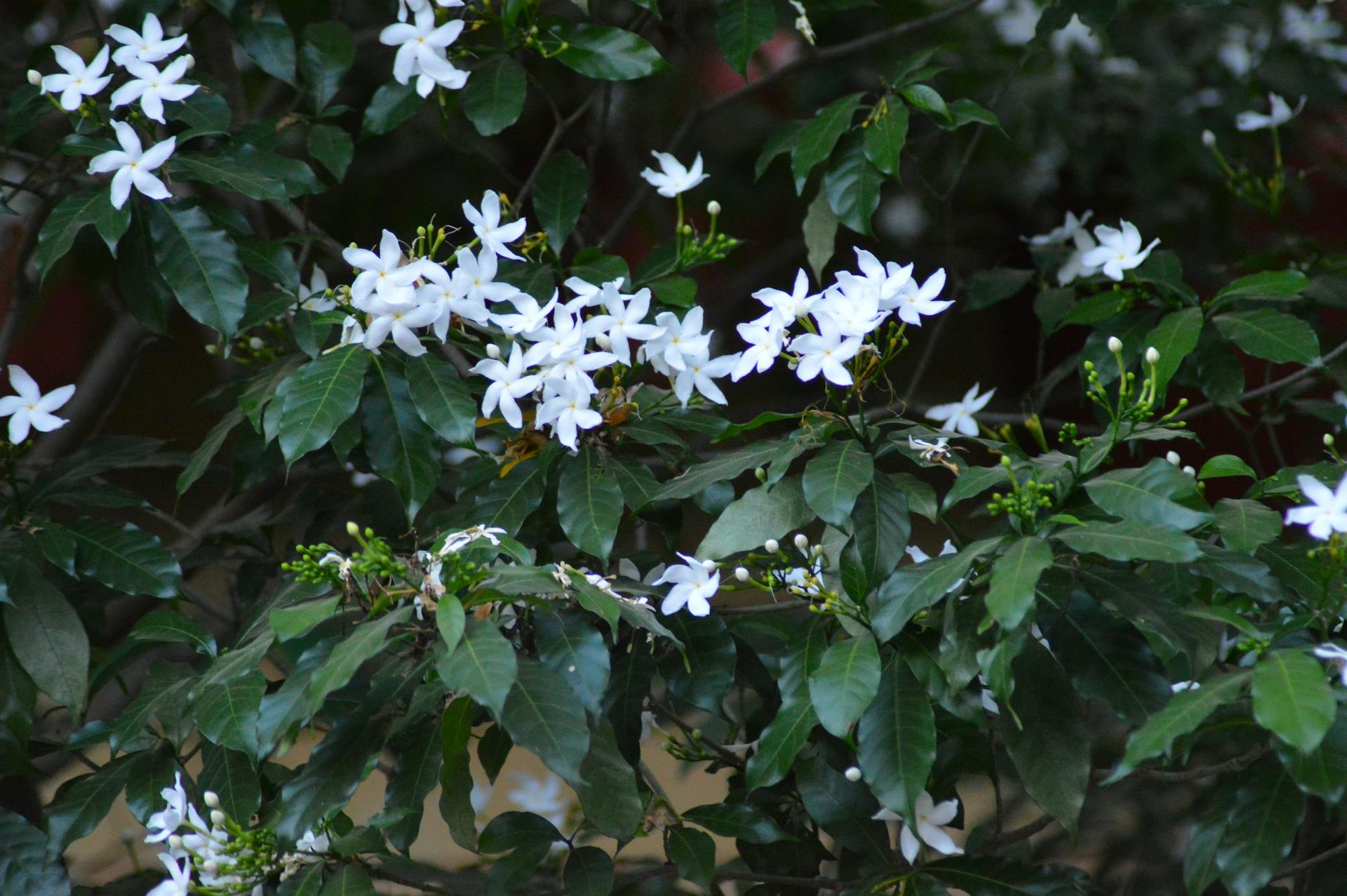Botanical Basics
- Common Name(s): Jasmine
- Folk Name(s): Moonlight Flower, Poet’s Jasmine, Jessamine
- Scientific/Latin Name: Jasminum officinale (Common Jasmine), Jasminum sambac (Arabian Jasmine), Jasminum grandiflorum (Spanish Jasmine)
- Family: Oleaceae (Olive family)
- Plant Type: Perennial shrub or climbing vine
- Botanical Description: Woody climber with slender stems and pinnate leaves. Produces clusters of star-shaped white, yellow, or pink flowers, intensely fragrant, especially at night. Some varieties evergreen, others deciduous.
- Growing Zones/Climate: USDA Zones 7–11 (species dependent)
- Best Zones for Growth: Subtropical to tropical climates; can be container-grown in cooler regions
- Habitat & Range: Native to Asia, the Middle East, and parts of Africa; cultivated globally for ornamental and perfumery purposes
Cultivation & Harvest
- Soil & Sun Requirements: Fertile, well-drained soil; prefers full sun to partial shade; thrives in warm, sheltered spots
- Propagation: By cuttings, layering, or seed (though seeds less common)
- Companion Planting: Pairs well with roses, lavender, and other fragrant ornamentals; attracts pollinators
- Harvesting Guidelines: Flowers handpicked in early morning or evening when fragrance is strongest; essential oils extracted via solvent or enfleurage
- Drying/Preservation: Flowers may be dried for tea blends or potpourri; essential oils and absolutes preserved in dark glass containers
Traditional & Historical Use
- Cultural Significance: Sacred flower in Hindu, Buddhist, and Islamic traditions; symbol of divine love, sensuality, and purity. Used in wedding garlands, temple offerings, and perfumes.
- Traditional Medicine: Used in Ayurveda and Chinese medicine for relaxation, as an aphrodisiac, and to relieve stress, headaches, and menstrual discomfort.
- Symbolism: Represents love, beauty, sensuality, purity, and spiritual awakening.
Medicinal & Practical Properties
- Active Constituents: Essential oils (benzyl acetate, indole, linalool, jasmone), flavonoids, tannins, alkaloids
- Medicinal Uses:
- Calming for anxiety, stress, and depression
- Aphrodisiac and mood enhancer
- Relieves menstrual cramps and balances hormones
- Mild antiseptic and skin soother
- Jasmine green tea aids digestion and immunity
- Preparation Methods: Infusions, teas, aromatherapy oils, massage oils, perfumes, tinctures
- Dosage & Guidelines:
- Tea: 1 tsp dried jasmine flowers per cup, steeped 5 min
- Essential oil: 2–3 drops diluted in carrier oil for massage or diffuser
- Safety/Precautions: Generally safe; essential oil should not be applied undiluted to skin. Pregnant individuals should avoid concentrated use.
Magical & Spiritual Properties
- Elemental Association: Water (linked to emotions, dreams, love)
- Planetary/Deity Correspondence: Moon and Venus; associated with goddesses of love (Aphrodite, Lakshmi, Isis)
- Magical Correspondences: Love, attraction, prophetic dreams, purity, spiritual connection, sensuality
- Ritual Use: Burned as incense for love spells and meditation; used in bath rituals to draw romance or self-love; placed under pillows to promote prophetic dreams; woven into garlands for blessings
- Symbolism in Divination/Dreams: Suggests romance, spiritual insight, or a period of emotional blossoming; may signify clarity through dreams
Ecological & Culinary Uses
- Pollinator Value: Highly attractive to bees, butterflies, and moths (especially night pollinators)
- Wildlife Uses: Provides nectar for beneficial insects; some species offer cover for small birds
- Culinary Uses: Used in jasmine teas (notably Jasminum sambac with green tea); flowers sometimes used for flavoring desserts, syrups, and rice dishes in Asian cuisine
Household/Practical Uses
- Quick Uses: Fragrance for rooms and clothing; calming tea; bath ritual herb; attraction charm
- Notable Traits: Intensely fragrant—often called the “queen of the night” due to evening bloom scent
- Special Notes: Essential oil (absolute) is one of the most prized and costly in perfumery; harvesting is labor-intensive, requiring thousands of blossoms for small amounts of oil

Supporting Notes
- Chevallier, Andrew. Encyclopedia of Herbal Medicine (2016)
- Grieve, M. A Modern Herbal (1931)
- Lawless, Julia. The Encyclopedia of Essential Oils (2014)
- Kapoor, L.D. Handbook of Ayurvedic Medicinal Plants (2001)
- Rätsch, Christian. Encyclopedia of Herbs and Spices (2005)
No comments:
Post a Comment